Timeline
Our season-by-season news review showcases some of the top headlines of the last 12 months.
Keep up to date with the latest stories
Summer 2017
A big deal for the city
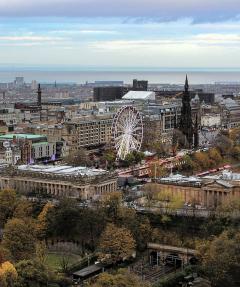
The deal is funding major infrastructure projects in the city, Lothians, Fife and Scottish Borders, with investment coming from the Scottish and Westminster governments and partners in local government and higher education.
The University is leading the City Region Deal’s exciting Data-Driven Innovation programme, with the aim of capitalising on the region’s rich seam of informatics, business and research expertise to make it the data capital of Europe.
Senior Vice-Principal Charlie Jeffery said: “We have a vision and capacity for technological innovation that can change and drive the economy.”
70 years of the festivals
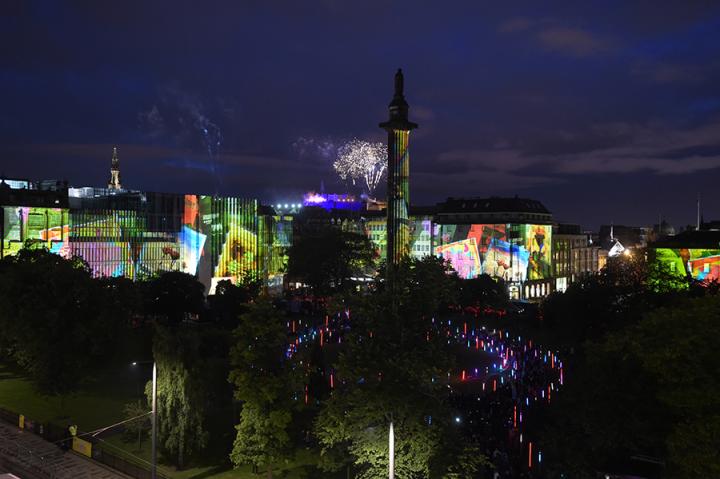
The University collaborates with organisers to host major events at the EIF, as well as the Edinburgh Festival Fringe and Edinburgh International Film Festival.
Among the 2017 highlights were: the University partnering with EIF for its epic 70th anniversary opening event entitled Bloom, during which projections lit up the city’s St Andrew Square; the University’s prestigious James Tait Black Prizes for Fiction and Drama being hosted once again at the Edinburgh International Book Festival; and Edinburgh academics presenting their research to the public in the Cabaret of Dangerous Ideas topical Fringe talk series.
Summer honorary graduations
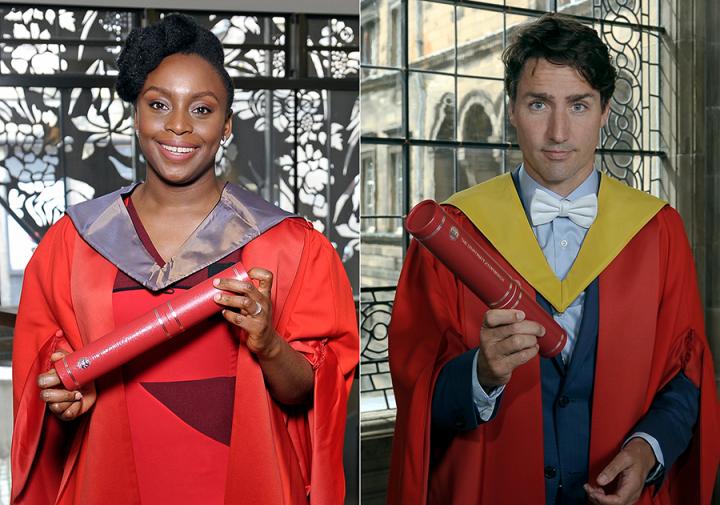
The Prime Minister of Canada, The Rt Hon Justin Trudeau (pictured right), was awarded an honorary degree of Doctor honoris causa at the newly refurbished McEwan Hall. The award was in recognition of Mr Trudeau’s achievements as a public servant with strong commitments to equality and diversity.
The acclaimed Nigerian author, (pictured left), was awarded an honorary degree of Doctor of Letters at the University’s redeveloped St Cecilia’s Hall, in recognition of her achievements as an author and public intellectual.
Filmmaker Oliver Stone, social enterprise entrepreneur Josh Littlejohn and China’s Vice-Premier Liu Yandong were also among those awarded honorary degrees over summer 2017.
The healing power of fish
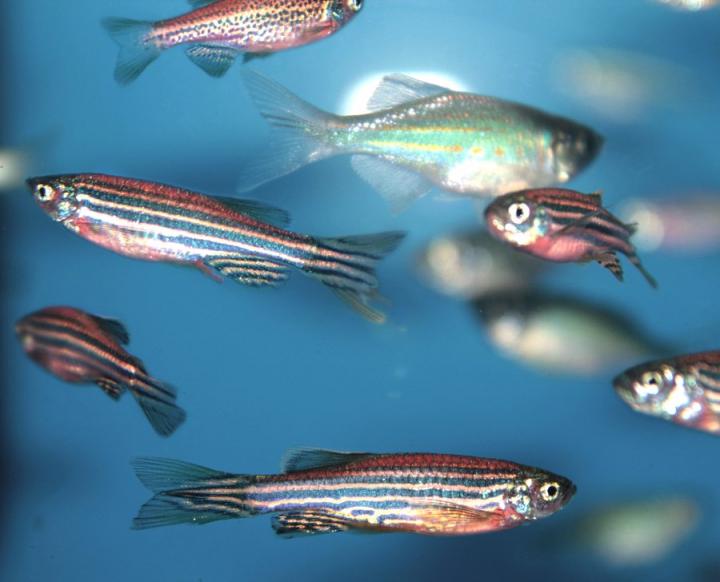
The findings could pave the way for treatments that help restore vital connections between the brain and muscles of the body that are lost in people after spinal cord injury.
Scientists at the University’s Centre for Neuroregeneration found that after injury, wound-healing cells called fibroblasts move into the site of damage.
These fibroblasts produce a molecule called collagen 12, which changes the structure of the support matrix that surrounds nerve fibres. This enables the damaged fibres to grow back across the wound site and restore the lost connections.
Autumn 2017
The University opens its doors
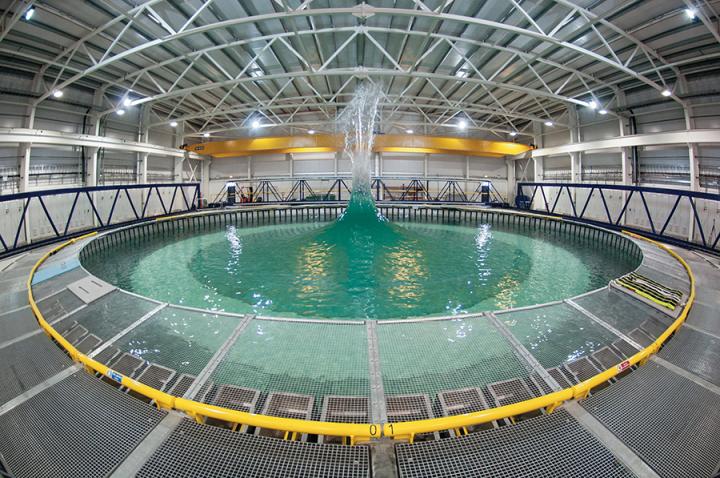
The event offered people a rare opportunity to see inside some of the most important architectural, social and cultural buildings in the city.
Visitors enjoyed access to many buildings including the University’s iconic McEwan Hall in the University’s Central Area; the FloWave Ocean Energy Research Facility at the King’s Buildings; and the Anne Rowling Regenerative Neurology Clinic at Little France. Each building provided information to help visitors learn more about its history, design and day-to-day functions, and many offered activities, exhibitions and talks.
Totally HypED

Following years of work, the team, called HypED, was invited to California to take part in the final of a contest to design the Hyperloop, a revolutionary new form of transportation. First proposed by billionaire inventor Elon Musk, the futuristic system is intended to transport passengers over land in pods travelling at around 750 mph in a near-vacuum tube.
HypED was the only team from the UK – and one of just four European groups – to reach the final. They joined 24 other teams at the competition weekend held at SpaceX’s headquarters in Hawthorne, California.
Making it to Mars

The study, involving Edinburgh scientists, will inform estimates of risk to such flights. The team collected 360 microbial samples from 20 locations during their isolation, using air filters and swabs. “Ours is the first comprehensive long-term study that investigates the number, diversity and changes in microorganisms in a closed habitat for the full duration of a simulated flight to Mars,” said Dr Petra Schwendner, School of Physics and Astronomy.
Nobel Prizes awarded
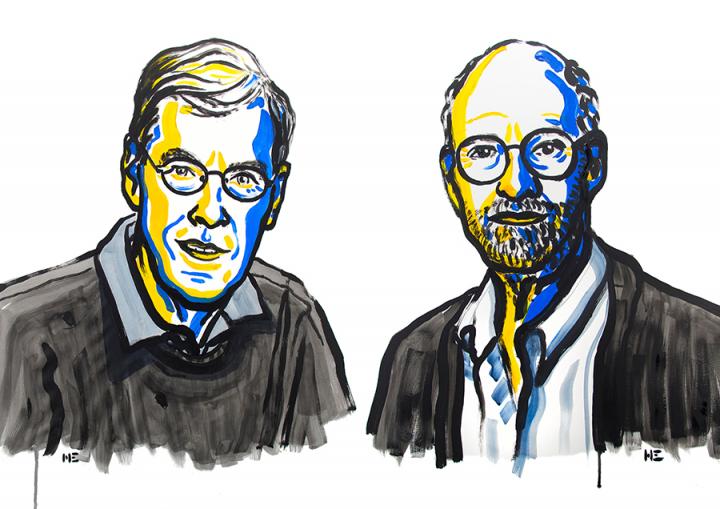
Dr Richard Henderson (left), winner of a Nobel Prize for Chemistry along with two of his colleagues, is an alumnus and honorary graduate of Edinburgh. The prize was awarded for developing cryo-electron microscopy, which has enabled high-resolution imaging of biomolecules in solution.
Professor Michael Rosbash (right), winner of a prize for Physiology or Medicine, was a researcher at Edinburgh in the early 1970s. He is one of three scientists recognised for their work in so-called circadian rhythms.
Winners of the Nobel Peace Prize, the International Campaign to Abolish Nuclear Weapons (ICAN), also have connections to the University. Read our interview with alumni Daniel Högsta and Dagmar Topf Aguiar de Medeiros.
From Old College to Oslo - The Edit interview
Medical quad renamed

The announcement was made by the University’s Chancellor, Her Royal Highness the Princess Royal, during a visit to Edinburgh. A plaque highlighting the square’s revised name – the Dr Elsie Inglis Quadrangle – was unveiled.
The Edinburgh-raised doctor and suffragist founded 17 Scottish Women’s Hospitals across Europe during the First World War. She also established a medical college for women and a maternity hospital for poor mothers in Edinburgh.
Winter 2017/18
Honouring women’s health
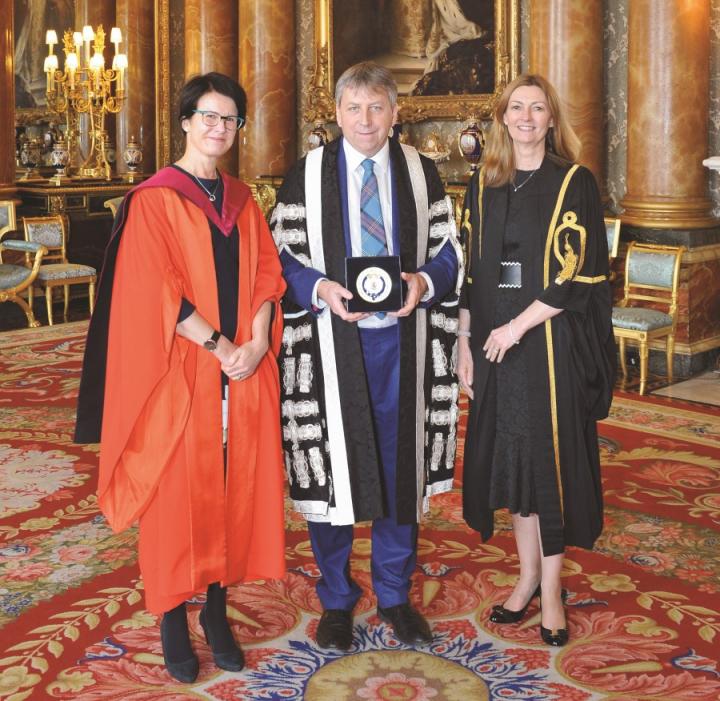
Work by Edinburgh scientists has helped give millions of women access to safe and effective contraception; developed life-saving treatments for breast and ovarian cancer; cut rates of still births and improved treatments for pregnancyrelated problems.
The Queen’s Anniversary Prizes are awarded every two years by The Queen on the Prime Minister’s advice. It is the third time in a row – and the fifth time ever – the University has received a Prize.
Photo: From left to right, Professor Jane Norman, Principal Peter Mathieson and Ms Anne Richards. (Correction: This is updated from the printed magazine which incorrectly captioned Professor Hilary Critchley on the right.)
Bill Gates visits Easter Bush

During the visit, Penny Mordaunt announced an investment of £4 million from the Department for International Development to fund scientists in Scotland, Africa, Australia and the USA to tackle livestock farming challenges in sub-Saharan Africa. This latest investment builds on a £10 million award from the Bill & Melinda Gates Foundation in 2015.
The event also celebrated the launch of the University’s new Global Academy of Agriculture and Food Security, which aims to provide world-leading research, innovation and learning in support of global food and environmental security, sustainable rural development, and animal and human wellbeing.
Our new Rector
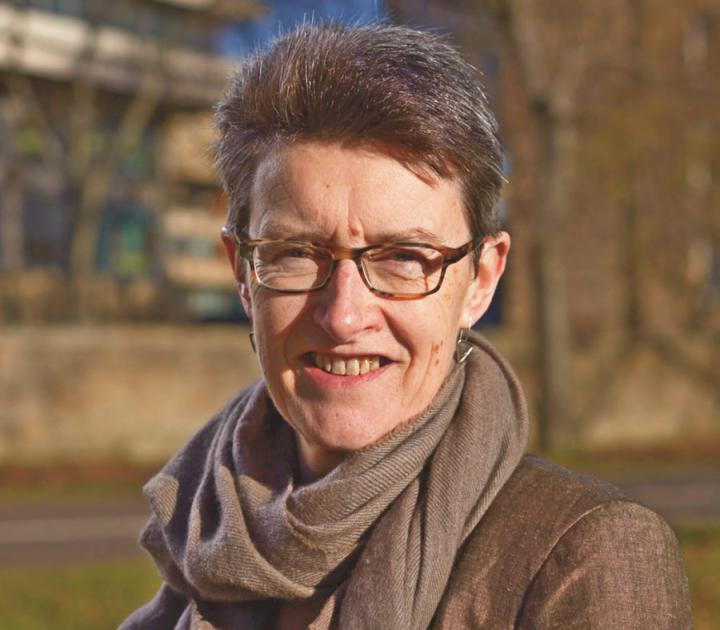
She became the second woman to hold the role since its creation in 1859. Muriel Gray was the first to do so in 1988.
Securing 2,324 votes in the Election of Rector 2018, she won 77 per cent of he vote to defeat fellow candidate Marco Bauder.
Boost for Edinburgh Futures
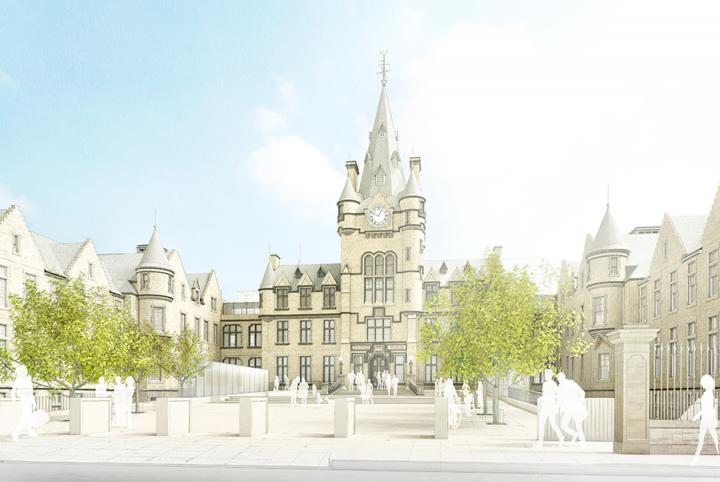
The gift – the biggest ever capital donation to the University – will help transform the city’s former Royal Infirmary into a state-of-the-art home for the Institute. Vice-Principal Professor Dorothy Miell, Head of the College of Arts, Humanities & Social Sciences, said: “The world is experiencing major changes: climate volatility, political discontent, advances in artificial intelligence, economic upheavals. We need different ways of thinking about these issues and of devising new solutions. Edinburgh Futures Institute will make that difference.”
Enlightened letters
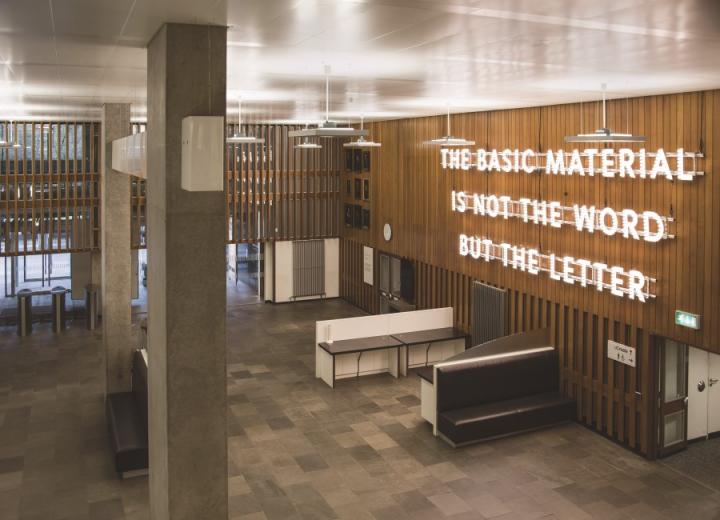
The enigmatic new public artwork was created by Turner Prize-nominated artist Nathan Coley. Neil Lebeter, Art Collections Curator at the University of Edinburgh, said: “The work is the result of a long relationship with Nathan Coley, and it is fitting that we unveil the eye-catching artwork 50 years after the Main Library was built.”
Spring 2018
Costumes and choreography

Fragments & Gestures: Performing Jenny Saville featured BA (Hons) Dance students from Edinburgh College wearing outfits designed by Performance Costume Masters students at Edinburgh College of Art.
The students performed original work – which explored ideas related to the body, performance, process and materials – alongside the inspirational artworks from Jenny Saville and several of her artistic peers.
The event is part of an ongoing relationship between Edinburgh College of Art, Edinburgh College and the National Galleries of Scotland. Previous work has been based on the art of Louise Bourgeois and Roy Lichtenstein.
Music in mind
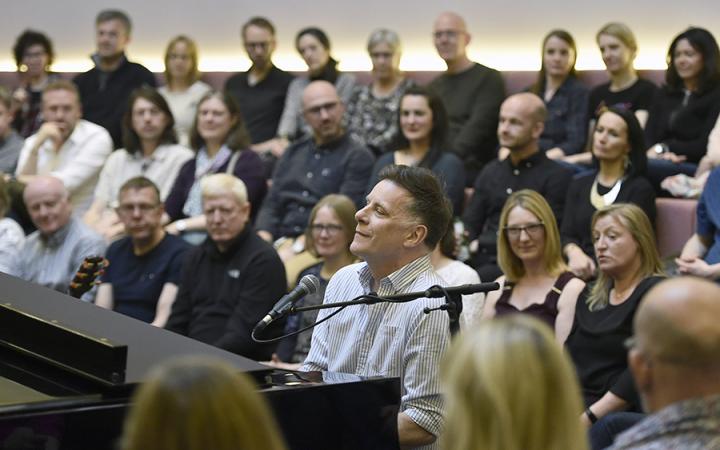
Deacon Blue’s Ricky Ross joined Del Amitri’s Justin Currie, along with former Danny Wilson singer Gary Clark, for a one-off performance, entitled Songs in the Round.
The event was hosted by broadcaster and alumna Sally Magnusson, who founded the charity Playlist for Life in memory of her late mother. The charity, which promotes the use of music to help those living with dementia, has teamed up with the University’s Centre for Dementia Prevention to research the relationship between music and brain health. Proceeds from the gig will go towards supporting this project.
Read the Edit magazine feature A dementia-free future
Commonwealth Games success
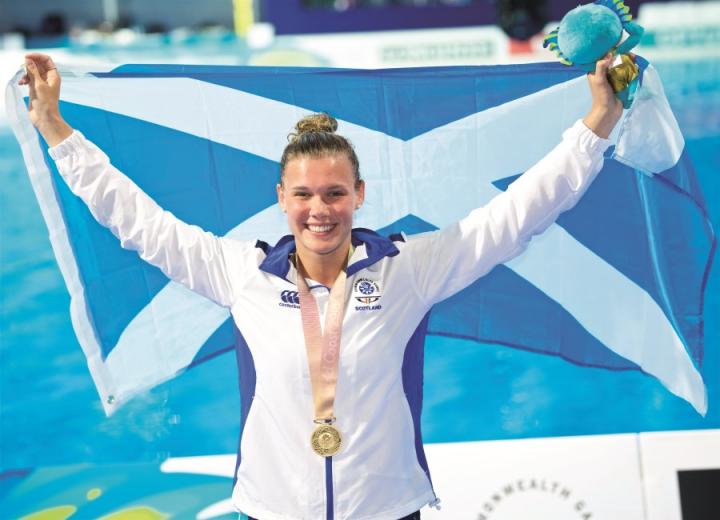
Leading sports men and women took nine medals, including gold, silver and bronze awards, at the Games. University swimmers and divers excelled in the pool, claiming a total of eight medals in a number of events, while a silver medal was won in the 400 metres hurdles. Sport science student Grace Reid (pictured) became the first Scottish female diver to win a medal at the Commonwealth Games, taking gold in the 1 metre springboard diving.
A trail into a lost world

The tracks, made some 170 million years ago, offer rare evidence of the Middle Jurassic period.
Paleontologist Dr Steve Brusatte, School of GeoSciences, explained: “This new site records two different types of dinosaurs – long-necked cousins of Brontosaurus and sharp-toothed cousins of Tyrannosaurus rex – hanging around a shallow lagoon, back when Scotland was much warmer and dinosaurs were beginning their march to global dominance.”
A healthy planet
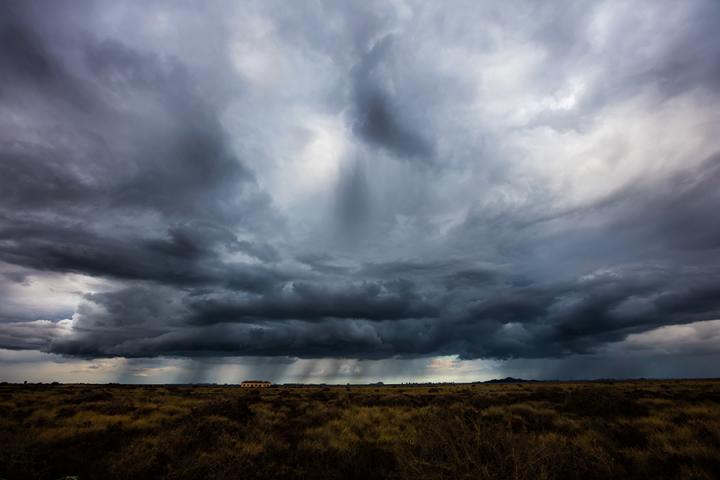
The Planetary Health Alliance is a consortium of universities, NGOs and other partners committed to the protection of human and environmental health. Chaired by Professor Liz Grant, the three-day event brought together researchers, policymakers and communities from around the world to discuss ways to reduce threats to human and ecosystem wellbeing.
To promote the concept of planetary health, and to generate knowledge and action, there is a list of simple, achievable pledges that individuals or alumni clubs can sign up to online.

